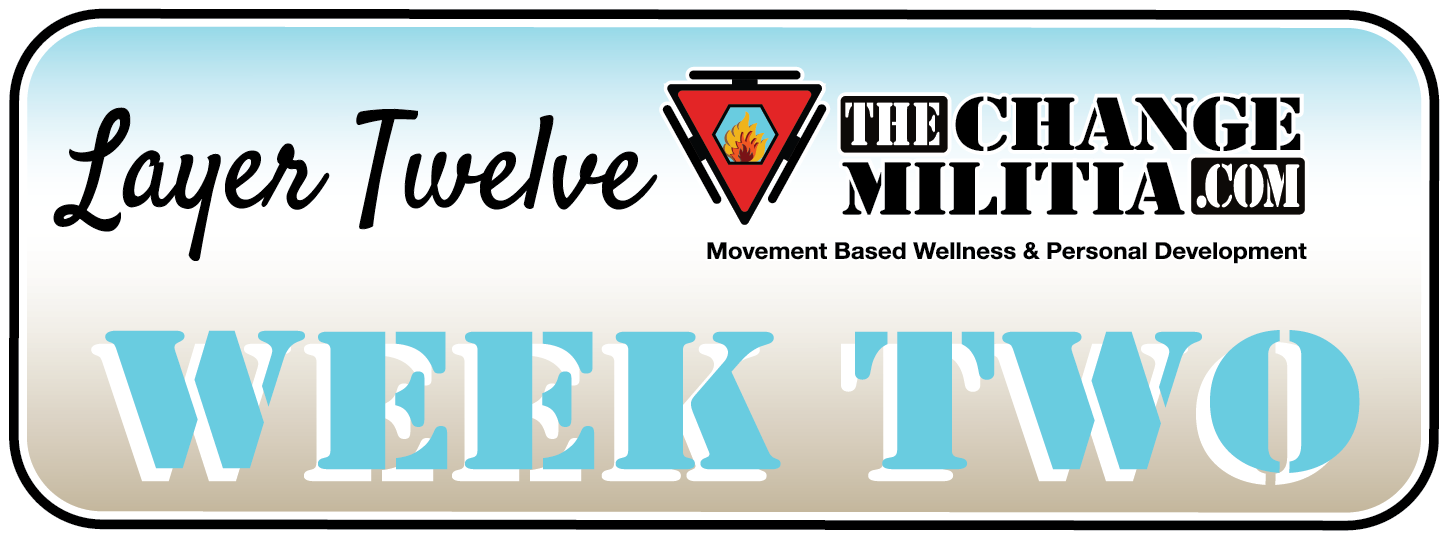Layer Twelve, Week Two – Sunday
- Read and review summaries of Layer One, Weeks One and Two
- Do one or all of these movements Current30, Feel Your Footfalls, Square Breathing and/or Sensory Awareness.
Sunday Focus
Layer One, Week One – Focus asked you to become aware of and detail your routines, patterns, and habits. Find and acknowledge the percentage of your day that they occupy, monopolize, and dominate. Challenge yourself to take a dozen of your habits and make a different decision. (Don’t overthink, just choose differently)
Layer One, Week Two – Focus asked you to do Current30’s on your physical sensations, emotions, state of mind. Listen to your excuses and ask yourself if they are actual and factual … or inventions and projections. Pay attention to the value you assign to actions, people, places, and things. Track how often you are fearful and how often your everyday actions, thoughts, emotions, and habitual movements are made without a conscious decision.
Sunday’s Concepts
Time for a year-end review. As you reread and redo, feel for the changes in your system, beliefs, actions, and reactions. How has the program helped you change? How have those changes helped you to change your world? Where are you now? What feels incomplete, unfinished, or half-baked? How empathetic are you? How kind, fulfilled, successful, happy, and playful? What could you change on the inside to make a bigger influence on the outside?
As you review, if anything doesn’t feel second nature, follow the links and review the concepts and accompanying movements. Take your time and hang out in the discomfort until your system adapts and integrates. At this point, you should feel the intention and the suggested results of each movement. If not, do each for a few days or until you do. Are you able to read without feeling confused, resistant, or oppositional? Can you feel the ideas and movements as sensations in your body?
If not, gift yourself some extra time, go back and feel deeper and fuller understandings. Build a stronger foundation.
My hope is that you will remain in this layer until the concepts, focus, and movements feel as comfortable as your favorite jeans.
Layer One, Week One Concepts introduced resistance and discomfort. Resistance is the physical, mental, and emotional manifestation of your fear. Discomfort is a sign that there are more stimuli (energy) present than your subconscious mind judges that you can digest safely.
As you develop a relationship with your energy and its configurations, learn to direct the flow of that energy toward your intentions, aspirations, and short-term goals.
When you understand what someone is feeling (their current energy configuration) and begin to communicate with that fear instead of reacting to their words, you will gain intimacy, empathy, and insight. Your communications will become transparent and effective.
Layer One, Week Two Concepts postulated that there is no good or bad energy, it is all energy. If it is moving, it is positive. How you label energy is a choice you can make. Stressed Out and Overwhelmed are labels you typically assign when your energy level is uncomfortable.
Anything and everything that you typically do that doesn’t have long term-benefits is your subconscious mind trying to burn excess energy.
When you consciously and tenaciously challenge your sub-optimal habits, your habits will change. The first step is to recognize that all your stories, images, truths, and beliefs about the world are fiction that your subconscious mind creates to keep you small, limited, and downtrodden. Every belief you have is limiting you in some way.
Healthy growth and adaptation require healthy discomfort. You gain strength, flexibility, and fluidity through adaptation. Your bodies (mental, emotional, and physical) will adapt to healthy discomfort and expand your range and capacity. You can rewrite what is normal, typical, and habitual when you consistently do things differently.
Empathy (the ability to feel what others are feeling) starts by beginning to have a fuller sense of what you are feeling. Your emotions are a composite of your sensations.
Layer Twelve, Week Two – Monday
- Read and review Monday Concepts
- Do one or more movement –Feel the Soul of Discomfort, Sit and Unwind, Level Two, Square Breath, Level Two and/or Sensation Awareness, Level Two.
Monday’s Focus
Layer One, Week Three – Focus: When you catch yourself doing something habitual, be aware of how familiar it feels in your body. Even if it is unhealthy, it will feel safe and your resistance to it will be minimal. Begin to connect the labels you assign to the sensations present in your body. Be aware of how people, places, and situations influence your body. Feel yourself tense or relax, become defensive or feel safe, and the increase or decrease your presence.
Layer One, Week Four – Focus: Is the tension, stress, and overwhelm you feel required? What might change if you choose not be tense, stressed, or overwhelmed? See if you can feel yourself transition as you start to get tense, stressed, or overwhelmed. Catch yourself in the act. And then see if you can convince yourself to choose differently.
Monday’s Concepts
Layer One, Week Three – Concepts opinioned that choices you make, the values you assign, and the challenges you allow yourself to embark upon determine the quality and timbre of your life.
If emotions are feelings … you are feeling something. If you are feeling something, there are sensations present. You always have sensations and your subconscious mind constantly tries to take your current set of sensations and label them as emotions. Your subconscious mind keeps flashing those emotional labels to your conscious mind until it grabs onto one.
You have tens of thousands of thoughts a day and choose to concentrate on only a small handful. From this handful, you determine what you focus on, judge, value, long for, resist, judge, and demand.
After you bring something into your conscious awareness, you have the ability to make a decision, to decide for yourself what to do with this awareness. Awareness is power, the power to determine, direct, and distinguish where you are currently and where you want to go next. You can use awareness as a constant feedback loop to increase your efficiency, productivity, and fulfillment.
Layer One, Week Four Concepts suggested that the things you do to relieve stress: exercise, medication, meditation, alcohol, food, sex, or therapy drain your energy. Then, you exert more energy trying to relieve it, creating a double deficit.
You are using stress like a thermostat, pressure release valve, or energy regulator. You create stress just so you can do something else to relieve it. The primary benefit of stress is to maintain and sustain a habitual range that mollifies your subconscious mind.
As you look to reconfirm your familiar ranges, it requires a dissipation of your excess vitality. You vent … with anger, sadness, injury, suffering, disease, jealousy, gossip, over-eating, under-eating, addiction, judgment, projection, subjectification, demand, blame, stress, Netflixing, over-exercising, etc. All these require and bleed energy, leaving you less vital.
Learn to devalue your stressors and eliminate that holding of energy. And most importantly, all the energy that you are expending worrying about stress, being stressed, and relieving stress could be spent on other things, things that bring you happiness, fulfillment, and success.
How you vent, your psychological and physiological diffusions, deficits, and dysfunctions become the WAY, not the WHY that you are sub-optimal.
Your personality is the combination and culmination of your habits. It is not who you are. Your personality reflects what you typically do. Your personality isn’t hard wired; it is habit wired. Change your habits and you will change your personality.
Layer Twelve, Week Two – Tuesday
- Read Tuesday Concepts
- Do one or more movement –Sit and Unwind, Level Three, Standing Meditation, Identifying Center, Square Breath, Level Three, and/or Sensation Awareness, Level Three
Tuesday’s Focus
Layer Two, Week One – Focus asked you to increase your awareness around the typical ways you allow yourself to be distracted. Become aware of what triggers your distractions. See if you can figure out what you were feeling before the trigger. Feel for the fullness before the distraction. That full quality is the key to adaptation, growth, and success. Feel for full, tolerate the healthy discomfort it offers and allow your systems to grow through adaptation.
Layer Two, Week Two – Focus: Explore the feelings of your energy in more depth. What observations can you make about your energy? If you are sad, mad, or glad, what sensations are you associating with those labels? What does it feel like in your body when you hold yourself back or when you think someone is holding you back? What sensations arise when you do (or contemplate doing) something that isn’t in line with your values?
Tuesday’s Concepts
Layer Two, Week One Concepts suggested that there are levels of compensation in everything we do. We are never 100% involved, committed, or invested. Compensation and resistance are how we limit our presence, connection, and engagement.
When you can highlight your compensations and resistance, you give yourself the opportunity to begin to alter, mitigate, or change them. You get stuck in your stuck places because your subconscious mind fears what it projects will happen in the next stage.
Explore each of the seasons in turn as it relates to the Square Breath (Inhale – Top Hold – Exhale – Bottom Hold).
The inhale is Spring, full of birth, growth and potential, a blossoming adolescence. The inhale holds the fear of your enoughness and the possibility of a new life. Your inhale is the season of opportunity and expansive transformation. Your inhale initiates movement and accepts a challenge. It is confidence and certainty.
Summer is the top hold, the confirmation of your enoughness in a wave of abundance. The top hold nullifies the excuse of insufficiency. It offers the opportunity to exist without limits. It is the place where you hold on to your possessions, whether they still serve you … or not. The top hold is the placeholder for the fear of success and your fear of fearlessness.
The exhalation is Fall, a falling off of current potential and a letting go of everything that no longer serves you. Your exhale challenges your perceptions of attachment, ownership, demand, entitlement, and expectation. Every exhale is the acceptance of your effort, determination, and hard work but also feeds the feelings of failure, incompleteness, and lost opportunities.
Winter, the bottom of the breath, slowly builds a vacuum where all potential is conceived. The bottom of the breath is silence. The bottom of the breath is the beating heart of contemplation and reflection. The bottom of the breath is the season of decay, deconstruction, poverty, and exhaustion. It is the time to remain empty, surviving harmoniously in quiet lack until a death and a new beginning occurs. The bottom of the breath is where grief digests, metabolizes, and turns into fuel.
Layer Two, Week Two Concepts proposed that to grow, progress, and achieve effortlessness, you must let go of what is holding you back. Every movement, action, and decision has some form of resistance and compensation. When you can highlight them, you give yourself the opportunity to begin to alter, mitigate, or change them.
I’ve put together a list of energy configurations as the gross indicators of your degree of receptivity and your levels of opposition and resistance. Your current and habitual moods (resistance configurations) will fall into one or more of these categories:
- Stagnant – Low, weak, and unmoving, stuck, lethargic, depressed;
- Compressive – Pent up, tense, strained, holding back, capitulated, constipated;
- Expansive – Growing, glowing, ecstatic, generous, blissful, elated;
- Transitive – Shifting, changing, unstable, mutable;
- Isometric – Pushing and pulling, conflicted, tense, passive-aggressive, actively nonmoving;
- Isotonic – Unbalanced isometric, concentric, eccentric, leaning, tense, resistant but moving;
- Fluid – Effortless, flowing without resistance, carefree, fearless, relaxed, confident;
- Fluctuating – Unresolved, variable, searching for balance;
- Percolating – Compressed but beginning to move;
- Explosive – Instant decompression, hyper-reactive;
- Scattered – Unfocused, multi-directional;
- Bleeding – Leaking, dissipating, deflating;
- Accumulating – Drawing in, actively ingesting with limited expansion. Pressurizing.
Each of your bodies: physical, mental, emotional, energetic, and environmental might hold a different resistance configuration.
All the configurations in each of your bodies: physical, mental, emotional, and energetic are created and controlled by your subconscious mind … until you make them conscious and decide to configure yourself differently. Decide wisely and often. Be fluid.
As you get better at identifying what your configurations are generally and specifically (through Current30’s); you can begin to alter and change them. If you generally feel stagnant, you will have tools to determine where specifically the stagnation exists.
Movement brings about change. When challenged in a healthy way, the systems begin working together, overcoming fear, resistance, and the subconscious mind’s desire to hold onto pain. When you lower your resistance, an uber-natural harmony and resonance is created, sometimes instantly. As your harmony increases, your capacities and capabilities expand.
Layer Twelve, Week Two – Wednesday
- Read Wednesday Concepts
- Do one or more movement –Walking Meditation, Sit and Unwind, Level Four, Square Breath, Level Four, and/or Sensation Awareness, Level Four.
Wednesday’s Focus
Layer Two, Week Three – Focus suggested that you explore the biases, stereotypes, and predispositions that influence you. Start with your parents and grandparents. What did they offer up as truth when you were a kid? What beliefs did they hold that limited their ability to be tolerant and empathetic? How do their beliefs still influence you? Do the same thing with your friends, teachers, and associates.
Layer Two, Week Four – Focus challenged you to investigate your personality. How do you respond and react to the goings on around you? What are your normals? If someone describes your personality, what do you think they would say? How often do you compare your current situation to some past event or future possibility?
Wednesday’s Concepts
Layer Two, Week Three Concepts presupposed that your images and beliefs are your defaults. Everything you believe to be true as a default (without determining its veracity in the moment) creates a bias, preference, and a prejudice. Every belief you have is limiting and creates an imbalance in your thinking, feeling, and posture.
Images and beliefs generate your demands. Your subconscious mind wants (demands) things to continue predictably. Demands are the rules by which your subconscious mind determines safe/unsafe, good/bad, right/wrong, and want/don’t want. Demands are the walls, floor, and ceilings your mind erects to limit your potential and the possibilities you can identify.
Your images, limiting definitions, aren’t actual or factual; they are proximal and situational. You create images to predefine what you are going to consider as inside or outside your comfort zone. Predefinition requires predicting future safety parameters and placing a perimeter on potential.
Images and beliefs define what you will value in the future as acceptable, desirable, and beneficial. Beliefs are the feeling side of images, the emotional curtains you draw to keep out everything that might dawn outside the windows of your circumscribed and inadmissible horizon. Most of your beliefs were taught to you. Your parents, friends, community, society, and culture told you what to think and how to be intolerant.
Layer Two, Week Four – Concepts: Your mind burns most of the energy it consumes deciding if this moment is subjectively better than some previous moment and what might be better in the next moment. Your personality is the outward display of these cycles of subjectivity. As you change your habits, you change who you are. As you change who you are, your personality and the personality of the world around you changes.
If something has value to you, it is limiting or draining your energy in some way. You give something life by creating a story about how it is important and how you would suffer if it was gone. You create a fictional future and then invest in that fiction. The degree to which you energize your stories is the amount they drain your vitality.
When you understand the fear at the core of your beliefs and the root cause of your attachments, you can begin to devalue them. As your beliefs lose value, your attachment to them is reduced. When they lose all value, they lose all attachment. Every belief you have, every limiting thought, pattern, addiction, or dysfunction can be devalued and let go. Facts and direct personal experience require zero energy; use that as a gauge. How hard do you have to convince yourself to continue to believe?
Layer Twelve, Week Two – Thursday
- Read Thursday Concepts
- Do one or more movement – Energy and Movement – Introduction, Adductor Pulse, Spiral Hips and/or Tolerate, Can’t Tolerate.
Thursday’s Focus
Layer Three, Week One – Focus: Take stock of your internal authority. How large and in charge do you feel? To whom or what do you regularly defer? As you make your way through the next few days, question authority. Spend the day examining who you allow to be responsible for your decisions, happiness, distractions, trajectory, schedule, and fulfillment.
Layer Three – Week Two – Focus: Feel how completely you immerse yourself in your distractions. Catch yourself, and begin to understand the all-consuming nature of distractions.Record the number of times you look at your phone, email, or social media. Ask yourself how much actual value distractions add to your life?
Thursday’s Concepts
Layer Three, Week One – Concepts: Your beliefs are where you hide, disguise, and obfuscate your fears. Look to the heart of every always and never, your absolutes, and you will find a belief that limits you.
All beliefs are limiting. Beliefs give a framework, a box that delineates what is inside and what is outside. Either things fit your belief or they don’t. Options and opportunities outside of your beliefs are viewed by your subconscious mind as either improbable or inconceivable and are discounted before ever being made conscious.
Beliefs make you lean in habitual directions. They keep you from being balanced, limit your productivity, and lower your efficiency. Accept that it is your right to self-determine your beliefs! Accepting and allowing that you have the right to determine what and how you believe is the first step toward self-responsibility and self-determination.
Personal responsibility is your ability to decide and your capability to respond. When you take personal responsibility, you will empower yourself, stop blaming others, and unlimit your opportunities. Personal responsibility keeps you from making demands and having expectations of others.
The primary entryway into personal responsibility is self-evaluation. Your sub-conscious mind constantly self-evaluates but rarely makes that information conscious. It determines possible threats and then whispers the associated fears into your head. Subconscious evaluations lead to habitual reactions. Habitual reactions are rarely the most productive, efficient, or beneficial.
Distractions will fall into three major categories, internal, external, and relational. Internal distractions will include your thoughts, feelings, and sensations, (gross and subtle). External distractions will include everything outside of your skin: people, circumstances, the environment, and things like social media. Relational distractions are ones that transit from internal to external or external to internal (things that intrude). Relational distractions include when someone grabs your arm, calls your name, creates a scene, or something diverts your attention by projecting energy into your space.
Layer Three – Week Two – Concepts: You give distractions an inordinate, even exorbitant, amount of your energy and attention. Reducing distractions starts with understanding their reality. Distractions are the primary tool your subconscious mind uses to keep you in a familiar range, to limit your growth, and to keep you from exploring what lies beyond your familiar horizons.
Observe and consider the distractions that pull your attention away from your intentions and you will see that they are almost always valueless. Sometimes distractions are conscious but most of the time your subconscious mind is driving the bus. It looks for distractions. The key isn’t what the nature of your distraction is; it is that it will always be out of line with your current intention or task.
Distractions are diverting, they bleed off energy. Your distractions pull you away from what you are doing. What you are doing generates energy and builds momentum. As the energy builds, you get energized beyond what is normal and that is disconcerting to your subconscious mind … and it starts looking for distractions.
You get distracted when you are out of balance. How out of balance you are will determine the level of the resulting distraction. Usually, the imbalance will occur when one of your bodies is more energized than the others. Energy, in excess of what is typical for you, triggers subconscious feelings of overwhelm and then your subconscious mind starts looking for ways to diffuse or bleed off some of that excess. It starts by looking for distractions. When it finds something to tempt your conscious mind, it latches on and starts looking for ways to make the distraction seem important.
Once you are distracted, your subconscious mind will try to keep you distracted, try to bleed off more energy. It might do this by adding value to the current distraction or by flinging new distractions at you. As you allow yourself to add value to distractions, you increase your attachment to them and they get harder to let go of or ignore the next time.
Layer Twelve, Week Two – Friday
- Read Friday Concepts
- Do one or more movement – Slow Motion Joint Articulation, Squat, Edges of the Breath, and/or No Sweat, Sweat.
Friday’s Focus
Layer Three, Week Three – Focus: Ask yourself where your life is in-line and out of line with the optimal. Be honest; don’t qualify your answer with arguments about time, resources, or opportunities. Begin to identify how, where, when, with whom, and to what degree you are typically unbalanced. When you are stressed or overwhelmed, try to identify the gross imbalance. Check in with each of your bodies and feel for anomalies. Refer to your list of energy configurations. Start with your mental body; the overwhelming majority of the time it will be the culprit.
Layer Three – Week Four – Focus: Catch yourself in your reactions and compensations and then reflect on your energy configuration just before you reacted and compensated. Feel for your edges, the places of increased vitality preceding your reactions and compensations.
Friday’s Concepts
Layer Three, Week Three Concepts: Let’s define balance as the place of optimum health in any given moment. And let’s define health as the place of optimum growth, function, fluidity, happiness, and fulfillment.
If balance is the place of optimum health and optimum health includes growth; your balance point will change, it will evolve as you grow. For example: if you are a runner and you run consistently, there will be a distance and speed that is optimal, a balance point between maximum benefit and overuse injury. As you progress, that distance and speed will change.
In every relationship, there is a balance point between autonomy and partnership. In your career, there is a balance point between the hours you work, your pay, and your responsibilities. Parenting gives you endless opportunities to balance mothering and smothering, independence and authority, and being supportive or controlling. Everything has an optimal balance point and that point will always be fluid.
Generally, five things influence your overall balance: your physical body, emotional body, mental body, subtle body and your environment. Each body influences every other body. And each body contributes to your overall balance.
Overwhelm, anxiety, and stress all result from an overactive subconscious mind and a subtle body that is out of balance. Creating, maintaining, and gaining an increased awareness of your balance points is the solution to stress.
Layer Three, Week Four Concepts: The typical progression/cycle that leads to your non-beneficial habits, failures, distractions, and dysfunctions is:
Expansion – Discomfort – Trigger – Distraction – Imbalance – Reaction – Compensation – Fatigue – Stress – Overwhelm – Dysfunction.
Reactions are movements instigated by your subconscious mind. Reactions will always leave you less vital. They drain your energy or have a negative return on your energetic investment (you get less back than you put in). Everything you do without a conscious decision is a reaction. Getting angry, offended, fearful, or elated are all usually reactions. An overwhelming majority of what you do is a reaction.
Compensations include mental and emotional things like stress, blame, resignation, jealousy, frustration, impatience, comparison, disconnection, anger, sadness, grief, awe, excitement, detachment, and every variety of fear. Physical compensations include tension, addictions, food, nail biting, foot tapping, gesturing, sex, exercise, and napping. Yes, even napping.
Your energy and vitality are being compromised by what you habitually do. Your reactions and compensations are draining you.
Fatigue can shift from one body to another as the cycle pulls energy from everywhere to fuel the on-going reactions and compensations. That is why you feel physically exhausted after doing your taxes, negotiating with a car salesman or when your two-year-old is screaming in the aisle of the Wal-Mart because he can’t have a four-foot-long Tootsie Roll.
Between good and bad, right and wrong, typical and atypical, exists a place of transition, a tolerable but uncomfortable range. Transitions are defined by the shift that occurs from okay to no longer okay. Your transitions are unstable, fluctuating, and mutable. These transitional ranges are what your subconscious mind uses to put your finger on the triggers of your distractions. They become the signal, the lights that flash and alarms that wail.
When you can discern the beginning and end of your range, you will begin to feel the edges of your edges, the expansive quickening. Each of your bodies will have its own transitional range and edge. Your mental range will be different than your emotional or physical range. Each range will affect every other range.
Getting to know your transitional ranges will allow you to identify when you are approaching the energy levels (expansive quickening) that lead to the triggers for your distractions and dysfunctions. When you can bring awareness to those energy levels you can fundamentally change your relationship with them.
Layer Twelve, Week Two – Saturday
- Read Saturday Concepts
- Do one or more movements from the preceding days that you haven’t already done.
Saturday’s Focus
Spend the day reflecting on the concepts and movements from the week. Ask your bodies if they are ready to move on to the next three layers of review. If not, spend some more time reviewing. It might be worthwhile to spend another week just doing the movements that don’t feel integrated.
Saturday’s Concepts
This week is a summation of the first three layers. If you are not intimately familiar with the ideas or concepts, I encourage you to spend some time reviewing the concepts, re-experiencing the focus, and redoing the movements.
Today, glance back over the concepts above and look for anything that feels dissonant. Track your resistance and give yourself the opportunity to explore what doesn’t feel true, easy, or fluid. Go back to that week’s content and read it in the original form. Spend a couple of days doing any of the movements that don’t have the suggested outcome.
My hope is that you will remain in this layer until the concepts, focus, and movements feel as comfortable as your favorite jeans.

















